On this Day in History ... 29th December
29 Dec is in December.
1170 Murder of Thomas a Becket
1680 Trial and Execution of William Howard 1st Viscount Stafford
Events on the 29th December
On 29 Dec 1158 Eleanor of Aquitaine Queen Consort Franks and England (age 36) travelled from Normandy [Map] on board the Esnecca (Snake) with her children Henry the Young King (age 3) and Matilda Plantagenet Duchess Saxony (age 2) to Southampton, Hampshire [Map]. She then went to Winchester, Hampshire [Map] where she collected funds from the Royal Treasury and returned to Normandy.
The Life of Thomas Becket by Edward Grim. Inspired by fury the knights called out, "Where is Thomas Becket, traitor to the king and realm?" As he answered not they cried out the more furiously, "Where is the archbishop?" At this, intrepid and fearless, as it is written, "The just, like a bold lion, shall be without fear," he descended from the stair where he had been dragged by the monks in fear of the knights, and in a clear voice answered "I am here, no traitor to the king, but a priest. Why do ye seek me?" And whereas he had already said that he feared them not, he added, "So I am ready to suffer in His name, Who redeemed me by His Blood: be it far from me to flee from your swords, or to depart from justice." Having thus said, he turned to the right, under a pillar, having on one side the altar of the blessed Mother of God and ever Virgin Mary, on the other that of S. Benedict the Confessor: by whose example and prayers, having crucified the world with its lusts, he bore all that the murderer could do with such constancy of soul as if he had been no longer in the flesh. The murderers followed him; "Absolve," they cried, "and restore to communion those whom you have excommunicated, and restore their powers to those whom you have suspended." He answered: "There has been no satisfaction, and I will not absolve them." "Then you shall die," they cried, "and receive what you deserve." "I am ready," he replied, "to die for my Lord, that in my blood the Church may obtain liberty and peace. But in the name of Almighty God, I forbid you to hurt my people whether clerk or lay." Thus piously and thoughtfully, did the noble martyr provide that no one near him should be hurt or the innocent be brought to death, whereby his glory should be dimmed as he hastened to Christ. Thus did it become the martyr-knight to follow in the footsteps of his Captain and Saviour Who when the wicked sought Him said: "If ye seek Me, let these go their way." Then they laid sacrilegious hands on him, pulling and dragging him that they might kill him outside the Church, or carry him away a prisoner, as they afterwards confessed. But when he could not be forced away from the pillar, one of them pressed on him and clung to him more closely. Him he pushed off calling him "pander," and saying, "Touch me not, Reginald; you owe me fealty and subjection; you and your accomplices act like madmen". The knight, fired with terrible rage at this severe repulse, waved his sword over the sacred head. "No faith," he cried, "nor subjection do I owe you against my fealty to my lord the king." Then the unconquered martyr seeing the hour at hand which should put an end to this miserable life and give him straightway the crown of immortality promised by the Lord, inclined his neck as one who prays and joining his hands he lifted them up, and commended his cause and that of the Church to God, to S. Mary, and to the blessed martyr Denys. Scarce had he said the words than the wicked knight fearing lest he should be rescued by the people and escape alive, leapt upon him suddenly and wounded this lamb who was sacrificed to God on the head, cutting off the top of the crown which the sacred unction of the chrism had dedicated to God; and by the same blow he wounded the arm of him who tells this. For he, when the others, both monks and clerks, fled, stuck close to the sainted archbishop and held him in his arms till the one he interposed was almost severed. Behold the simplicity of the dove, the wisdom of the serpent, in the martyr who opposed his body to those who struck that he might preserve his head, that is his soul and the Church, unharmed, nor would he use- any forethought against those who destroyed the body whereby he might escape. O worthy shepherd, who gave himself so boldly to the wolves that his flock might not be torn. Because he had rejected the world, the world in wishing to crush him unknowingly exalted him. Then he received a second blow on the head but still stood firm. At the third blow he fell on his knees and elbows, offering himself a living victim, and saying in a low voice, "For the Name of Jesus and the protection of the Church I am ready to embrace death." Then the third knight inflicted a terrible wound as he lay, by which the sword was broken against the pavement, and the crown which was large was separated from the head; so that the blood white with the brain and the brain red with blood, dyed the surface of the virgin mother Church with the life and death of the confessor and martyr in the colours of the lily and the rose. The fourth knight prevented any from interfering so that the others might freely perpetrate the murder. As to the fifth, no knight but that clerk who had entered with the knights, that a fifth blow might not be wanting to the martyr who was in other things like to Christ, he put his foot on the neck of the holy priest and precious martyr, and, horrible to say, scattered his brains and blood over the pavement, calling out to the others, "Let us away, knights; he will rise no more."
The Conquest of Ireland Chapter 20. The Martyrdom of St. Thomas
Raymond pursuing his journey and having arrived at court with the earl's letter, the king received him with great coldness, and being as usual much occupied with business, deferred his reply.
About that time, Thomas, archbishop of Canterbury, in England, perished by the hands of impious men, to the dismay of the great men of the realm, both lay and clerical; after having undergone the sufferings of banishment for nearly seven years in much grief, wearing sackcloth on every part of his body, and giving himself up to reading and prayer, besides, the most severe of all afflictions, a grievous proscription which spared no one, of whatever age or sex, his martyrdom at last filled up the measure of his sufferings and glory. He himself threw open the doors of the sanctuary to his furious enemies, and meeting boldly their drawn swords, bowed his consecrated head to their violence. This took place in the mother and metropolitan church, and before the altar. There he received four wounds on the crown of his head, the shaven crown which used to be regarded as a token of the protection due to the clergy, inflicted by four brutal retainers of the court, with more than brutal rage.1 The illustrious soldier and martyr of Christ was thus distinguished by intrepidly suffering in that part of the body which betokened Christ's sufferings during his passion, and exchanged a corruptible for an incorruptible crown. He also hallowed the holy week of Christmas by then shedding his blood; and as the fifth day before Christmas is consecrated to the memory of the first Thomas, so the second Thomas shed glory on the fifth day after Christmas.2 The one was the light of the East, the other of the West; one illuminated the infant church, the other the church of the latter days; and as the one cemented the foundations of the rising church with his blood, so the other, by shedding his blood, renewed the primitive virtues, and restored the edifice which in the lapse of so many ages had fallen to decay by the injuries of time, and the violence of the storms to which it had been exposed. The first Thomas was actuated by an ardent faith, the second was more than fervent when faith was now growing old. The one submitted to cruel torments while erecting the frame of the church, the other did not shrink from meeting death in order to preserve that frame uninjured. His triumphant claims to such glory are well summed up in the two following verses:
Pro Christi sponsa, Christi sub tempore, Christi
In templo Christi verus amator obit.
In Christ church, and at Christmas tide,
For Christ's spouse, Christ's true servant died.
Among his numerous miracles, there was one which was very memorable, and is well worthy of being mentioned namely, the marvellous way in which he restored organs which had been actually lost; for by this novel kind of miracle it plainly appeared that he was a new martyr. Hence some one has said,
Miratur rediisse virum neutratus, ocelli [He is surprised that the husband has returned, neutral, blind]
Succedunt oculis, albus hic, ille niger [The eyes succeed, this white, that black]
In order that no caviller might object that they were the same eyes which the sufferer had before, and to shew that they were not merely injured but actually plucked out, the new organs of sight were smaller and of a different colour, and had the power of seeing not only in the light of day, but in the dark.
Note 1. A quatuor aulicis canibus, rabie plusquam canina furentibns. [From the four court dogs, more rabid than canines]
Note 2. The feast of St. Thomas, the apostle, is held on the 21st December, and that of St. Thomas a Becket on the 29th December.
On 29 Dec 1170 Archbishop Thomas Becket (age 51) was murdered at Canterbury Cathedral [Map] by four knights on behalf of King Henry "Curtmantle" II of England (age 37). Whether the ordered the murder, or whether the four knights were acting without orders, is a matter of conjecture.
On 29 Dec 1299 William Morley 1st Baron Morley was created 1st Baron Morley by writ of summons to King Edward I's (age 60) 47th Parliament. Isabel Mohaut Baroness Morley by marriage Baroness Morley.
Letters and Papers 1529. 29 Dec 1529. R. O. 6115. Cardinal Wolsey (age 56).
Grant by Wolsey to George Boleyn (age 26), knt., Viscount Rochford, son and heir apparent of Thomas Earl of Wiltshire and Ormond (age 52), of an annuity of £200 out of the lands of the Bishopric of Winchester, with power to distrain for nonpayment.
ii. Similar grant of an annuity of 200 marks out of the abbey lands of St. Albans.
Letters and Papers 1535. 29 Dec 1535. Vienna Archives. 1035. Charles V. to [Chapuys].
Received, on the 24th inst., his letters of 21 Nov. The ill will of the king of England to the Queen and Princess (age 50) is cruel and horrible. It is impossible to believe that he would be so unnatural as to put them to death, considering his ties to them, their descent, their virtues and long sufferings. He probably intends by threats to make them swear to and approve his statutes. There are two reasons against their taking the oath:—One, that it would alienate and discourage the good people of England, and be a means for the King and his concubine gaining the good will of all. The other is, that the King would perhaps take it as a further reason for revenging himself on them for having so long refused, and would assume that their taking the oath was an acknowledgment of the fault of disobedience, and therefore deserving the same punishment. He would suppose that the oath was taken by the Emperor's advice. Chapuys must do what he can to avoid their taking the oath without letting them run an irremediable risk. Hopes to do something for them at the approaching interview with the Pope, from his Holiness's desire to chastise the King for his daily insults to him and the Holy See. Will wait also to see whether the enterprise for which his man was sent can be carried out. He must, however, advise them to take the oath rather than lose their lives, protesting that they do it from fear. It cannot then prejudice their rights. Protestation to this effect shall be made by their proctor at Rome. Chapuys must assure them that the Emperor will take care of their interests when at Rome. Naples, 29 Dec. 1535.
Fr., from a modern copy, pp. 2.
On 29 Dec 1595 Frances Berkeley (age 31) died. She was buried at Church of St Mary and St Hardulph, Breedon on the Hill [Map]. Monument to Frances Berkeley (age 31) and George Shirley 1st Baronet (age 36). The armorial shows  Shirley Arms and
Shirley Arms and  Berkeley Arms impaled. Cadaver Underneath. Attributed to Jasper Hollemans.
Berkeley Arms impaled. Cadaver Underneath. Attributed to Jasper Hollemans.

Frances Berkeley: Around 1564 she was born to Henry Berkeley 7th Baron Berkeley and Katherine Howard Baroness Berkeley. After 21 Feb 1587 George Shirley 1st Baronet and she were married.
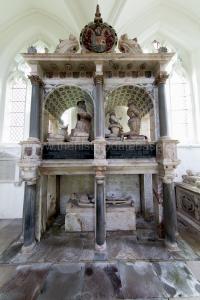
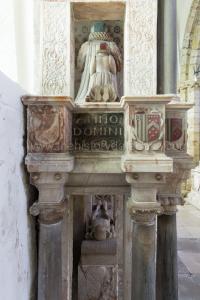
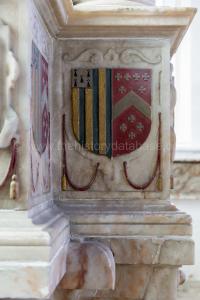
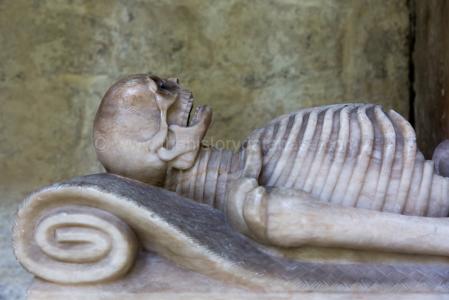
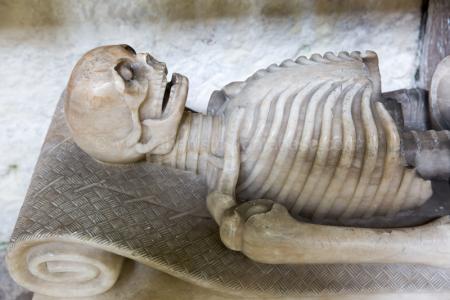
On 29 Dec 1655 Charles Killigrew was born to Thomas Killigrew (age 43) and Charlotte Hesse (age 26) in Maastricht.
Evelyn's Diary. 29 Dec 1680. The Viscount Stafford (age 66) was beheaded on Towerhill [Map].
On 29 Dec 1680 William Howard 1st Viscount Stafford (age 66) was beheaded at Tower Hill [Map]. He was attainted; Viscount Stafford forfeit. His wife Mary Stafford Countess Stafford (age 60), with whom he was jointly created Baron Stafford continued as Baroness.

Evelyn's Diary. 29 Dec 1686. I went to hear the music of the Italians in the new chapel, now first opened publicly at Whitehall [Map] for the Popish Service. Nothing can be finer than the magnificent marble work and architecture at the end, where are four statues, representing St. John, St. Peter, St. Paul, and the Church, in white marble, the work of Mr. Gibbons (age 38), with all the carving and Pillars of exquisite art and great cost. The altar piece is the Salutation; the volto in fresco, the Assumption of the blessed Virgin, according to their tradition, with our blessed Savior, and a world of figures painted by Verrio. The throne where the King (age 53) and Queen (age 28) sit is very glorious, in a closet above, just opposite to the altar. Here we saw the Bishop in his mitre and rich copes, with six or seven Jesuits and others in rich copes, sumptuously habited, often taking off and Putting on the Bishop's mitre, who sat in a chair with arms pontifically, was adored and censed by three Jesuits in their copes; then he went to the altar and made divers cringes, then censing the images and glorious tabernacle placed on the altar, and now and then changing place: the crosier, which was of silver, was put into his hand with a world of mysterious ceremony, the music playing, with singing. I could not have believed I should ever have seen such things in the King of England's palace, after it had pleased God to enlighten this nation; but our great sin has, for the present, eclipsed the blessing, which I hope he will in mercy and his good time restore to its purity.
John Ashton Edmund Elliot Richard Graham 1691. On Fryday, the 2d day of this Sessions, my Lord Preston (age 41), John Ashton and Edmund Elliot, were all Arrained for High Treason, my Lord Preston (age 41) was Tryed on Saturday by the name of Sir Richard Graham, Mr. Ashton on Monday. The Indictments against them consisted of Two Parts, the First of which set forth, That they had a Treasonable Design carrying on to Depose the King and Queen, and to Subvert and Alter the Government of the Kingdom of England, and to raise War and Rebellion in the same; which said Traiterous and Wicked Designs and Purposes to bring to pass, they did, on the 29th of December last, Meet and Conspire together, with several other Traitors not yet discovered, and did Compose several Treasonable Letters, Notes and Memorandums in writing, which set forth the most effectual way and means how they might Dethrone and Depose our Most Gracious Sovereign Lord and Lady the King (age 40) and Queen (age 28), and further describing therein how the Affairs of this Kingdom stood, and of what Strength and Force our Shipping was; as also the Fortifications of several Sea-Port-Towns within this Kingdom. The Second Part was their adhering to the Kings's Enemies: And to that end, that they might Acquaint Lewis the French King of the same, they did hire a Boat and Embarque themselves in order to Transport themselves and Pacquet of Treasonable Letters into France, agreeing to pay for their said Passages the Sum of One hundred Pound; and, in order to their Treasonable Voyage, they had made their Passage as far as below Gravesend [Map], but were then Taken by Captain Billop, who Cruised abroad to search for them.

After this the Evidence for the King (age 40) being called, gave an Account particularly from Step to Step, how cunningly and subtilly they managed this horrid Conspiracy, by hiring the Smack called the Thomas and Elizabeth, to convey them secretly into France; in order to which they took Water in a Skuller at Surrey-Stairs, and went on Board the aforesaid Vessel, which lay in the River of Thames over against the Tower [Map]: From thence they set Sail down the River, till coming within the View of the George Frigate, lying in Long-reach, they desired the Master of the Smack to hide them under the Quarter-Hatches; which was done, they having some Fear of being discovered: There they remained till past that Danger, and then came up; but when they were within Sight of Gravesend [Map] they hid again, and a little below it Captain Billop came aboard them, under Pretence of Pressing the Masters two Men, who were assistants to him; but indeed his Design and real Intention was to find out those Traytors, which, upon Search, he found lying along under the Hatches; and after their being haled up he search'd them, and found a Pacquet of Treasonable Papers in Mr. Ashton's Bosom: which he with the Prisoners carried before my Lord Nottingham; who examined the Papers, and after being examined by the Cabinet Council they were committed to the Tower. The Evidence was very full and plain against them both, much to the same effect and purport: The Letters being also Read against them in Court, were adjudged to be of no less Import than High-Treason. Upon the whole they had nothing material to offer in their Defence; so after a very long hearing, they were both found Guilty of High Treason. Edmond Elliot was ordered to remain till further order.
Evelyn's Diary. 29 Dec 1694. The smallpox increased exceedingly, and was very mortal. The Queen (deceased) died of it on the 28th.
On 29 Dec 1735 Thomas Banks was born.
In Dec 1800 King George III of Great Britain and Ireland (age 62) created a number of peers who supported the Act of Union ....
On 21 Dec 1800 Charles Stanley Monck 1st Viscount Monck (age 46) was created 1st Viscount Monck.
On 29 Dec 1800 ....
Murrough O'Brien 1st Marquess Thomond (age 74) was created 1st Marquess Thomond. Mary Palmer Marchioness Thomond (age 50) by marriage Marchioness Thomond.
Charles Tottenham aka Loftus 1st Marquess Ely (age 62) was created 1st Marquess Ely in County Wexford. Jane Myhill Marchioness Ely by marriage Marchioness Ely in County Wexford.
James Alexander 1st Earl Caledon (age 70) was created 1st Earl Caledon in County Tyrone.
On 29 Dec 1808 Henry William Paget 1st Marquess Anglesey (age 40) commanded the cavalry at the Battle of Benavente whe defeated the elite Chasseurs à cheval of the French Imperial Guard.
On 29 Dec 1825 Jacques-Louis David (age 77) died.
After 29 Dec 1828. Monument in St Mary's Church, Swinstead [Map] to Priscilla Barbara Elizabeth Bertie 21st Baroness Willoughby of Eresby (deceased) sculpted by James Forsyth in 1883. An elaborate Gothic Aedicule of limestone. Above the Recessed inscription an achievement of arms of the Bertie's.
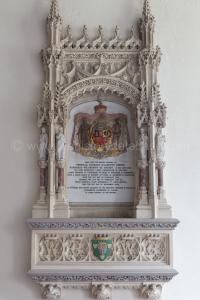
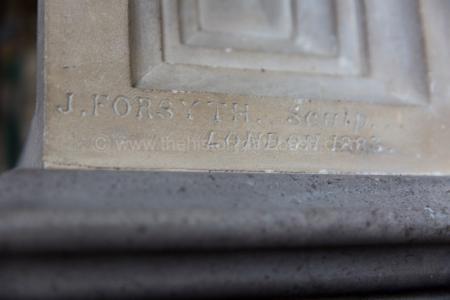
On 29 Dec 1855 Matthew Noble (age 38) and Frances Mary Claxton (age 28) were married.
On 29 Dec 1867 Baron Pietro Marochetti (age 62) died.
On 29 Dec 1886 Margaret York Countess of Salisbury was beatified as a martyr by Pope Leo XIII.
Births on the 29th December
On 29 Dec 1552 Henri Bourbon Condé Prince Condé was born to Louis Bourbon Prince Condé (age 22) and Eléanor de Roucy de Roye Princess Condé (age 17).
On 29 Dec 1615 Charles Scarburgh was born to Edmund Scarburgh at St Martin in the Fields [Map].
On 29 Dec 1615 Charles Scarborough was born.
On 29 Dec 1625 Alice Spencer Countess Drogheda was born to William Spencer 2nd Baron Spencer (age 34) and Penelope Wriothesley Baroness Spencer Wormleighton (age 27).

On 29 Dec 1640 William Feilding 2nd Earl Desmond 3rd Earl Denbigh was born to George Feilding 1st Earl Desmond (age 26) and Bridget Stanhope Countess Desmond (age 25).

On 29 Dec 1643 William Howard was born to Francis Howard (age 55) at Corby Castle, Cumberland [Map].
On 29 Dec 1655 Lewis Watson 1st Earl Rockingham was born to Edward Watson 2nd Baron Rockingham (age 25) and Anne Wentworth Baroness Rockingham (age 26).

On 29 Dec 1655 Charles Killigrew was born to Thomas Killigrew (age 43) and Charlotte Hesse (age 26) in Maastricht.
On 29 Dec 1676 William Wrightson of Cusworth was born to Robert Wrightson of Cusworth and Sarah Beaumont.
On 29 Dec 1704 Basil Murray was born to John Murray 1st Duke Atholl (age 44) and Catherine Hamilton Duchess Atholl (age 42).

On 29 Dec 1709 Edward Mainwaring was born to Edward Mainwairing (age 28) and Jemima Pye.
On 29 Dec 1721 Jeanne Poisson "Madame de Pompadour" Marquise de Pompadour was born.
On 29 Dec 1735 Thomas Banks was born.
On 29 Dec 1737 John Bentinck was born to Willem Bentinck (age 33).
On 29 Dec 1741 Walter Campbell 3rd of Islay was born to John Campbell (age 45).
On 29 Dec 1741 Walter Campbell of Shawfield was born.
On 29 Dec 1752 Cecil Bisshopp 12th Baron Zouche was born to Cecil Bisshopp 7th Baronet.
On 29 Dec 1757 William Lowther 1st Earl Lonsdale was born to William Lowther 1st Baronet (age 50).
On 29 Dec 1758 Simon Thomas Scrope was born to Simon Scrope.
On 29 Dec 1785 William Sefton George Stanhope was born to Charles Stanhope 3rd Earl of Harrington (age 32) and Jane Fleming Countess Harrington (age 30). He a great x 3 grandson of King Charles II of England Scotland and Ireland.
On 29 Dec 1798 Algernon Frederick Greville was born to Charles Greville (age 36) and Charlotte Cavendish-Bentinck (age 23).

On 29 Dec 1809 William Ewart Gladstone was born to John Gladstone 1st Baronet (age 45) and Anne MacKenzie Robertson (age 37).
On 29 Dec 1810 Adeliza Elizabeth Gertrude Manners was born to John Henry Manners 5th Duke Rutland (age 32) and Elizabeth Howard Duchess Rutland (age 30).

On 29 Dec 1810 Thomas Grey was born to Charles Grey 2nd Earl Grey (age 46) and Mary Elizabeth Ponsonby Countess Grey (age 34).

On 29 Dec 1810 Elizabeth Laura Wodehouse was born to John Wodehouse 2nd Baron Wodehouse (age 39) and Charlotte Norris Baroness Woodhouse.
On 29 Dec 1812 William Wentworth Brabazon Ponsonby was born to John Ponsonby 4th Earl Bessborough (age 31) and Maria Fane (age 25).

On 29 Dec 1820 Dudley Marjoribanks 1st Baron Tweedmouth was born to Edward Marjoribanks (age 44).
On 29 Dec 1830 Cornelius Jeremiah Vanderbilt was born to Cornelius "Commodore" Vanderbilt (age 36) and Sophia Johnson Coefficient of inbreeding 3.12%.
On 29 Dec 1831 John Francis Arundell 12th Baron Arundel was born to Henry Benedict Arundell 11th Baron Arundel (age 27) and Frances Catherine Tichborne Baroness Arundel.
On 29 Dec 1857 Courtenay Robert Percy Vernon 3rd Baron Lyveden was born to Courtenay John Vernon (age 29).
On 29 Dec 1860 Tatton Lane-Fox Willoughby was born to Henry Willoughby 8th Baron Middleton (age 43) and Julia Louisa Bosville Baroness Middleton (age 36).
On 29 Dec 1863 Lieutenant Mildmay Edward Fane was born to Francis Augustus Fane (age 38) and Augusta Fane (age 32) at Malta. Coefficient of inbreeding 6.25%. 
On 29 Dec 1868 William Trench 5th Earl of Clancarty was born to Richard Trench 4th Earl of Clancarty (age 34) and Adeliza Georgiana Hervey Countess Clancarty (age 25).
On 29 Dec 1871 Francis John Lascelles was born to Henry Thynne Lascelles 4th Earl Harewood (age 47) and Diana Smyth Countess Harewood (age 33).
On 29 Dec 1871 Sybil Cholmondeley was born to Hugh Cholmondeley 2nd Baron Delamere (age 60) and Augusta Emily Seymour-Conway Baroness Delamere (age 36).

On 29 Dec 1873 Oswald Mosley 5th Baronet was born to Oswald Mosley 4th Baronet (age 25) at Beaumaris, Anglesey.
On 29 Dec 1873 Charles Cospatrick Douglas-Home 13th Earl of Home was born to Charles Douglas-Home 12th Earl of Home (age 39) and Maria Gray Countess of Home (age 24).
On 29 Dec 1874 George Charles Montagu 9th Earl Sandwich was born to Rear-Admiral Victor Alexander Montagu (age 33) and Agneta Harriet Yorke (age 36).

On 29 Dec 1879 Sydney Edward Marsham was born to Charles Marsham 4th Earl Romney (age 38) and Frances Augusta Constance Muir Rawdon-Hastings Countess Romney (age 35).
On 29 Dec 1882 Henry Edward Fitzherbert was born to Richard Fitzherbert 5th Baronet (age 36) and Mary Anne Arkwright Lady Fitzherbert (age 32).
On 29 Dec 1899 William Graham Esplen 2nd Baronet was born to John Esplen 1st Baronet (age 36).
On 29 Dec 1900 Andrew Shirley was born to Walter Shirley 11th Earl Ferrers (age 36) and Mary Jane Moon Countess Ferrers.
On 29 Dec 1902 Edward Pakenham 6th Earl of Longford was born to Thomas Pakenham 5th Earl of Longford (age 38) and Mary Julia Child-Villiers Countess Longford (age 25).
On 29 Dec 1924 Charles John Jessel 3rd Baronet was born to George Jessel 2nd Baronet (age 33) and Muriel Gladys Chapline Lady Jessel (age 40).
On 29 Dec 1946 Marianne Faithfull was born to Major Robert Glynn Faithfull.
On 29 Dec 1952 Robert William Saswalo Shirley 14th Earl Ferrers was born to Robert Shirley 13th Earl Ferrers (age 23).
Marriages on the 29th December
On 29 Dec 1558 Gómez Suárez de Figueroa y Córdoba 1st Duke of Feria (age 38) and Jane Dormer Duchess Feria (age 20) were married.
On 29 Dec 1574 George Carey 2nd Baron Hunsdon (age 27) and Elizabeth Spencer Baroness Hunsdon and Eure (age 22) were married.

On 29 Dec 1627 Alexander Stewart (age 18) and Anne Howard (age 15) were married. She the daughter of Charles Howard 1st Earl Nottingham and Margaret Stewart 1st Countess Nottingham (age 36). He the son of Alexander Stewart 1st Earl Galloway (age 47). She a great x 4 granddaughter of King Henry VII of England and Ireland. 


On 29 Dec 1629 William Savile 3rd Baronet (age 17) and Anne Coventry Baroness Savile (age 17) were married.

Before 29 Dec 1640 George Feilding 1st Earl Desmond (age 26) and Bridget Stanhope Countess Desmond (age 25) were married. He the son of William Feilding 1st Earl Denbigh (age 53).

On 29 Dec 1685 Daniel Finch 2nd Earl Nottingham 7th Earl Winchilsea (age 38) and Anne Hatton Countess Nottingham and Winchelsea were married. She by marriage Countess Nottingham. He the son of Heneage Finch 1st Earl Nottingham and Elizabeth Harvey Baroness Finch.
On 29 Dec 1748 Reverend William Chichester (age 26) and Mary Bellamine were married.
Before 29 Dec 1798 Frederick William Hervey 1st Marquess of Bristol (age 29) and Elizabeth Albana Upton (age 23) were married. He the son of Frederick Augustus Hervey 4th Earl Bristol (age 68) and Elizabeth Davers Countess Bristol (age 65).

On 29 Dec 1798 Charles Hanbury-Tracy 1st Baron Sudeley (age 20) and Henrietta Susanna Tracy were married.
On 29 Dec 1803 Godfrey Bosville Macdonald (age 28) and Louisa Maria La Coast Hanover (age 21) were married at Norwich, Norfolk [Map]. She the illegitmate daughter of William Henry Hanover 1st Duke Gloucester and Edinburgh (age 60) and Almeria Carpenter (age 51). She a great granddaughter of King George II of Great Britain and Ireland. 
On 29 Dec 1820 Reverend Miles Stapleton (age 19) and Anne Byam Kerby were married.
On 29 Dec 1836 Christopher William Codrington (age 31) and Georgiana Charlotte Anne Somerset (age 19) were married. She the daughter of Henry Somerset 7th Duke Beaufort (age 44) and Georgiana Frederica Fitzroy. They were third cousin once removed. He a great x 4 grandson of King Charles II of England Scotland and Ireland. She a great x 5 granddaughter of King Charles II of England Scotland and Ireland. 

On 29 Dec 1855 Matthew Noble (age 38) and Frances Mary Claxton (age 28) were married.
On 29 Dec 1860 Charles Swinton Hogg (age 36) and Harriet Anne Stirling were married.
Before 29 Dec 1924 George Jessel 2nd Baronet (age 33) and Muriel Gladys Chapline Lady Jessel (age 40) were married.
Deaths on the 29th December
Florence of Worcester Continuation. 29 Dec 1122. John, bishop of Bath, died on the fourth of the calends of January [29th December]: during his lifetime he had bought the whole city of Bath from king Henry for five hundred pounds.
On 29 Dec 1170 Archbishop Thomas Becket (age 51) was murdered at Canterbury Cathedral [Map] by four knights on behalf of King Henry "Curtmantle" II of England (age 37). Whether the ordered the murder, or whether the four knights were acting without orders, is a matter of conjecture.
On 29 Dec 1210 Maud de Braose died.
On 29 Dec 1302 Jean II de Harcourt (age 67) died.
On 29 Dec 1397 Archibishop Robert Waldby died. He was buried at the Chapel of St Edmund, Westminster Abbey [Map].
After 29 Dec 1440 Robert Witham of Grantham died.
On 29 Dec 1502 John Digges (age 57) died.
On 29 Dec 1508 John Kennedy 2nd Lord Kennedy (age 54) died.
On 29 Dec 1540 Hugh Hastings 14th Baron Hastings (age 35) died. His son John Hastings 15th Baron Hastings (age 9) de jure 15th Baron Hastings.
On 29 Dec 1559 Elizabeth Grey Baroness Chandos (age 67) died. She was buried at St Faith's under St Paul's [Map].
On 29 Dec 1594 John Duncombe (age 90) died.
On 29 Dec 1595 Frances Berkeley (age 31) died. She was buried at Church of St Mary and St Hardulph, Breedon on the Hill [Map]. Monument to Frances Berkeley (age 31) and George Shirley 1st Baronet (age 36). The armorial shows  Shirley Arms and
Shirley Arms and  Berkeley Arms impaled. Cadaver Underneath. Attributed to Jasper Hollemans.
Berkeley Arms impaled. Cadaver Underneath. Attributed to Jasper Hollemans.

Frances Berkeley: Around 1564 she was born to Henry Berkeley 7th Baron Berkeley and Katherine Howard Baroness Berkeley. After 21 Feb 1587 George Shirley 1st Baronet and she were married.





On 29 Dec 1624 Dermod McMurrough O'Brien 5th Baron Inchiquin (age 30) died.
On 29 Dec 1625 Henry Hobart 1st Baronet (age 65) died. He was buried at St Andrew's Church, Blickling [Map]. His son John Hobart 2nd Baronet (age 32) succeeded 2nd Baronet Hobart of Intwood in Norfolk. Frances Egerton Lady Hobart by marriage Lady Hobart of Intwood in Norfolk.

On 29 Dec 1630 Oliver St John 1st Viscount Grandison (age 71) died. His great nephew William Villiers 2nd Viscount Grandison (age 16) succeeded 2nd Viscount Grandison. Mary Bayning Countess Anglesey (age 7) by marriage Viscountess Grandison.


On 29 Dec 1635 Charles Denny died.
On 29 Dec 1648 Arthur Mainwaring (age 68) died.
On 29 Dec 1659 Spencer Compton (age 23) died.
On 29 Dec 1677 Robert Digby 3rd Baron Digby (age 23) died. His brother Simon Digby 4th Baron Digby (age 20) succeeded 4th Baron Digby of Geashill in County Offaly. Frances Noel Baroness Digby by marriage Baroness Digby of Geashill in County Offaly.

On 29 Dec 1680 William Howard 1st Viscount Stafford (age 66) was beheaded at Tower Hill [Map]. He was attainted; Viscount Stafford forfeit. His wife Mary Stafford Countess Stafford (age 60), with whom he was jointly created Baron Stafford continued as Baroness.

On 29 Dec 1683 John Monson 2nd Baronet (age 84) died. His grandson Henry Monson 3rd Baronet (age 30) succeeded 3rd Baronet Monson of Carleton in Lincolnshire.
On 29 Dec 1689 Thomas Sydenham "Father of English Medicine" (age 65) died at his house in Pall Mall [Map]. He was buried in St James' Church, Piccadilly.
On 29 Dec 1693 Vere Fane 4th Earl of Westmoreland (age 48) died. His son Vere Fane 5th Earl of Westmoreland (age 15) succeeded 5th Earl of Westmoreland, 8th Baron Despencer, 5th Baron Burghesh in Suffolk.
On 29 Dec 1714 General Charles Churchill (age 58) died.
On 29 Dec 1719 Philip Bourbon (age 7) died.
On 29 Dec 1721 Thomas Rouse 4th Baronet died. Baronet Rouse of Rouse Lench in Worcestershire extinct.
On 29 Dec 1732 Geoffrey Palmer 3rd Baronet (age 77) died without issue. His nephew Thomas Palmer 4th Baronet (age 30) succeeded 4th Baronet Palmer of Carlton in Northampton.
On 29 Dec 1740 Edward Seymour 5th Baronet (age 79) died. His son Edward Seymour 8th Duke of Somerset (age 45) succeeded 6th Baronet Seymour of Berry Pomeroy. Mary Webb Duchess Somerset (age 43) by marriage Lady Seymour of Berry Pomeroy.
On 29 Dec 1746 Anna Orange Nassau died.
On 29 Dec 1765 Frederick Hanover (age 15) died.
On 29 Dec 1772 John Astley 2nd Baronet (age 85) died. Baronet Astley of Patshull extinct.
On 29 Dec 1795 Mary Murray Countess Findlater (age 75) died.
On 29 Dec 1803 Hester Amelia Vincent Countess Clanricarde died.
On 29 Dec 1806 Charles Lennox 3rd Duke Richmond (age 71) died at Goodwood West Sussex. He was buried at Chichester Cathedral [Map]. His nephew Charles Lennox 4th Duke Richmond (age 42) succeeded 4th Duke Richmond, 4th Earl March, 4th Baron Settrington. Charlotte Gordon Duchess Richmond (age 38) by marriage Duchess Richmond.
On 29 Dec 1813 Alexander Bannerman 6th Baronet (age 72) died. His son Alexander Bannerman 7th Baronet (age 44) succeeded 7th Baronet Bannerman of Elsick in Kincardineshire.
On 29 Dec 1825 Jacques-Louis David (age 77) died.
On 29 Dec 1828 Priscilla Barbara Elizabeth Bertie 21st Baroness Willoughby of Eresby (age 67) died. Her son Peter Drummond Burrell 2nd Baron Gwydyr 22nd Baron Willoughby (age 46) succeeded 22nd Baron Willoughby de Eresby. Clementina Sarah Drummond Baroness Gwydyr and Willoughby (age 42) by marriage Baroness Willoughby de Eresby.
On 29 Dec 1836 John Charles Ramsden (age 48) died.
On 29 Dec 1836 Emily Gascoigne (age 36) died.
On 29 Dec 1841 Edward Boscawen 1st Earl Falmouth (age 54) died. His son George Boscawen 2nd Earl Falmouth (age 30) succeeded 2nd Earl Falmouth, 5th Viscount Falmouth.
On 29 Dec 1845 Charles Gregory Pigot aka Fairfax (age 77) died. Gilling Castle, North Yorkshire [Map] appears to have been inherited by his two daughters Lavinia Fairfax (age 43) and Harriet Fairfax (age 41) and their husbands Reverend James Alexander Barnes (age 47), Rector of Gilling, and Francis Cholmeley (age 35) respectively.
On 29 Dec 1849 John Howard (age 68) died. He was buried at St Oswald's Church, Brereton [Map].
On 29 Dec 1852 Reverend Francis Hodgson (age 71) died at the Provost's Lodge, Eton College. He was buried at Eton College Chapel [Map].
On 29 Dec 1858 Horatio Walpole 3rd Earl Orford (age 75) died. His son Horatio Walpole 4th Earl Orford (age 45) succeeded 4th Earl Orford, 5th Baron Walpole of Wollerton.
On 29 Dec 1867 Baron Pietro Marochetti (age 62) died.
On 29 Dec 1872 George Musgrave 10th Baronet (age 73) died. His son Richard Courtenay Musgrave 11th Baronet (age 34) succeeded 11th Baronet Musgrave of Hartley Castle in Westmoreland. Adora Frances Olga Wells Lady Musgrave (age 23) by marriage Lady Musgrave of Hartley Castle in Westmoreland.
On 29 Dec 1878 Major-General William Wilberforce Greathed (age 52) died.
On 29 Dec 1878 Arthur Hay 9th Marquess Tweedale (age 54) died without issue.
On 29 Dec 1879 Emma Stapleton died.
On 29 Dec 1888 Reverend Frederick John Norman (age 73) died.
On 29 Dec 1893 William King Noel 1st Earl Lovelace (age 88) died. His son Ralph King-Milbanke 2nd Earl of Lovelace (age 54) succeeded 2nd Earl Lovelace, 2nd Viscount Ockham of Ockham in Surrey.
On 29 Dec 1894 Christina Georgina Rossetti (age 64) died. She was buried in the Rossetti Family Grave.
On 29 Dec 1901 Frances Marsham (age 92) died.
On 29 Dec 1906 Dorothea Hester Bluett Wallop Lady Rycroft died.
On 29 Dec 1909 Edward Knatchbull-Hugessen 2nd Baron Brabourne (age 52) died. His son Wyndham Knatchbull-Hugessen 3rd Baron Brabourne (age 24) succeeded 3rd Baron Bradbourne.
On 29 Dec 1909 George Bridges Rodney 7th Baron Rodney (age 52) died. His son George Bridges Rodney 8th Baron Rodney (age 18) succeeded 8th Baron Rodney of Rodney Stoke in Somerset.
On 29 Dec 1922 Kenelm Charles (age 21) died of pneumonia unmarried. His brother Mark Everard Pepys 6th Earl of Cottenham (age 19) succeeded 6th Earl of Cottenham, 6th Viscount Crowhurst of Crowhurst in Surrey, 6th Baron Cottenham of Cottenham in Cambridgshire, 8th Baronet Pepys of Wimpole Street, 9th Baronet Pepys of Brook Street.
On 29 Dec 1924 Arthur Frederick Bligh (age 59) died.
On 29 Dec 1934 Mildred Mary Josephine de Trafford Baroness Bellow (age 78) died.
On 29 Dec 1939 Wilfred Henry Montgomery Finch (age 57) died. The last of the Finch male line. The estate passed to a cousin Colonel James Robert Hanbury who sold within a year.
On 29 Dec 1946 Ralph Shirley (age 80) died.
On 29 Dec 1953 Kathleen Douglas-Pennant Viscount Falmouth (age 92) died.
On 29 Dec 1963 Hugh Mccorquodale 1898-1963 (age 65) died.
On 29 Dec 1972 Rosa Bingham Countess Warwich and Brooke (age 59) died.
On 29 Dec 1986 Harold Macmillan 1st Earl Stockton (age 92) died. His grandson Alexander Daniel Macmillan 2nd Earl of Stockton (age 43) succeeded 2nd Earl of Stockton, 2nd Viscount Macmillan of Ovenden, of Chelwood Gate in East Sussex and of Stockton-on-Tees in Cleveland.
On 29 Dec 2008 John Wyndham Hanmer 8th Baronet (age 80) died. His son Wyndham Richard Hanmer 9th Baronet (age 53) succeeded 9th Baronet Hamner of Hamner in Flintshire.
On 29 Dec 2009 Anthony Gerard Edward Noel 5th Earl of Gainsborough (age 86) died. His son Anthony Noel 6th Earl of Gainsborough (age 59) succeeded 6th Earl Gainsborough, 8th Baron Barham. Sarah Rose Winnington Countess Gainsborough (age 58) by marriage Countess Gainsborough.